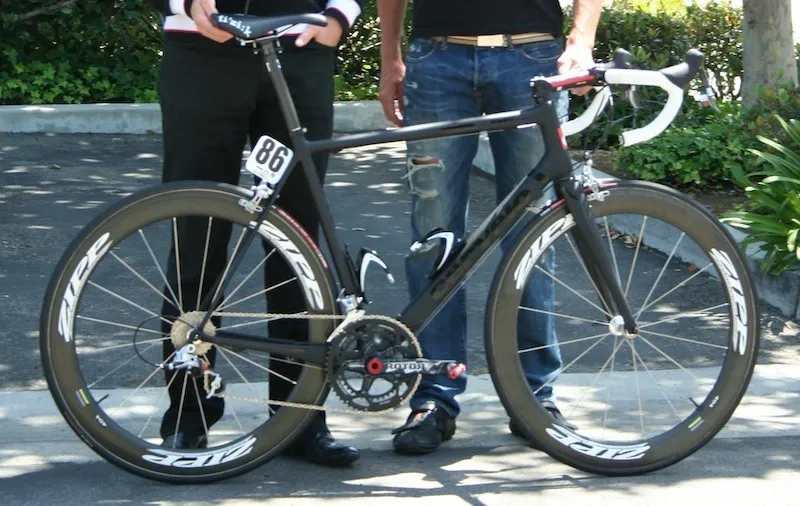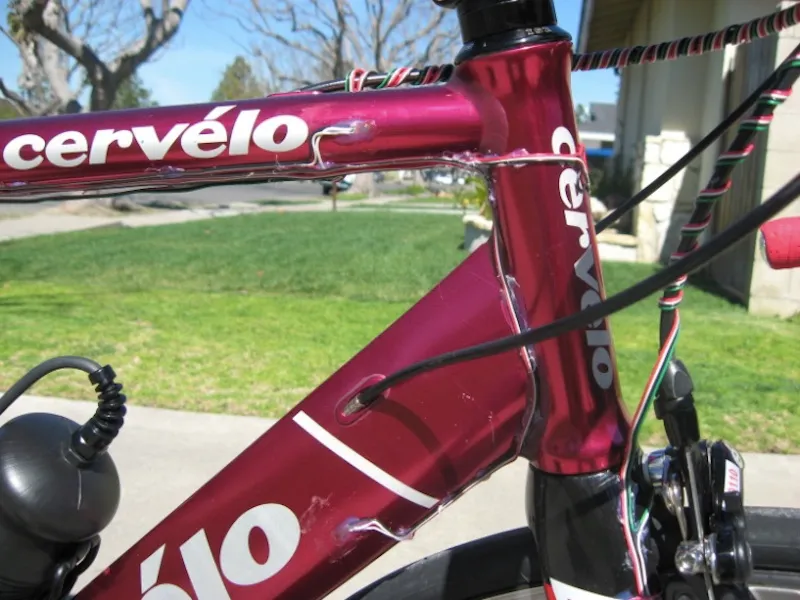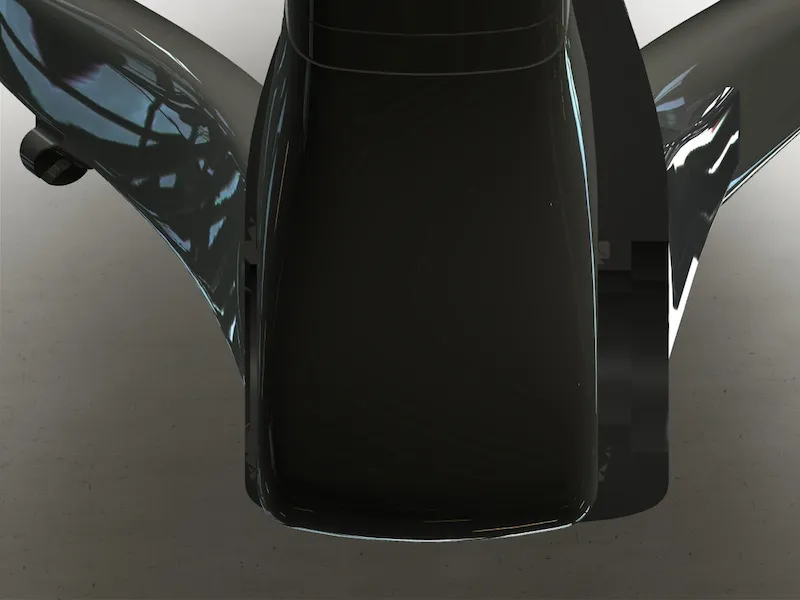After giving us a tantalising glimpse back in February, Cervélo have finally unveiled their lightest, stiffest and most expensive bike yet – the R5ca. Costing US$9,800 (frameset only) and with a claimed sub-700g frame weight, it's the result of three years' work at the company's Project California design facility.
The new bike had a target weight of 700g, but in production Cervélo claim 675-680g for a 54cm frame including all of its hardware – paint, derailleur mounts, seat collar and even bottle cage bolts. This weight shaving does not come at the expense of stiffness, however, and the chassis meets all of the brand’s internal test standards, most of which exceed industry standards.
The first framesets (frame, fork, headset and BBright Rotor crankset) will be available in about three weeks. Cervélo estimate they will produce 300 of the R5ca frames per year.
In addition to carbon layup and material improvements (more on this below), the bike has a bevy of new-for-Cervélo features including a tapered head tube and steerer, proprietary BBright bottom bracket standard and refined geometry. Bottom bracket cable guides have been refined, there's a new rear derailleur hanger and front derailleur mount, and a new seat tube collar.
Attention to detail
In most cases, Cervélo first considered carbon for the R5ca’s accessories, but for pieces like the seat binder and front derailleur braze-on, it proved to be the wrong material for the job. “We figured if we made this part out of carbon [the front derailleur mount], it would be lighter,” said Cervélo co-founder Phil White. “But it’s one of those parts where you’re always applying clamping loads and you’re tightening up that nice sharp washer into carbon. That’s not a good load for it to handle.
"We found it wasn’t durable enough in the field so we just scrapped it and went to a higher grade aluminium. The aluminium is a far better solution for that loading so we went back to it. The carbon part was 3g lighter but the aluminium made more sense; it’s a much more durable product.” It's a similar story with the seatpost collar, which is also made from aluminium. More durable than anything Cervélo engineers could find or manufacture out of carbon, and it weighs just 11g.
Everything on the R5ca was refined – even the items that tend to be afterthoughts on most bikes. Cervélo were able to reduce shift lever actuation force by a claimed 40 percent by routing the cables through a specially designed guide on the underside of the bottom bracket. This was essential because Shimano’s redesigned Ultegra and Dura-Ace groupsets require more lever force, which is why the bulk of the Cervélo Test Team decided to continue on the older 7800 shifters throughout 2009.
“It really pushed us to refine the cable routing,” said White. “We were able to drop that lever force by 30 to 50 percent, which is a fairly huge difference considering all we did was make some subtle changes. We found a really neat North American material that we can get just around the corner from where we make the frames and it has significantly lower friction than something you can get off the shelf from China or Taiwan."
"These are the sort of things that will show up all the way across the product line pretty quickly but aren’t terribly sexy," he added. "You don’t sell a lot of bikes because of cable routing – not too many people look under the bottom bracket – but you’ll really appreciate it out on the road.”
The right head tube taper
Cervélo believe some of their competitors have gone too far when it comes to front end stiffness. Their testing concluded that a 1-1/2in (1.5in) head tube bearing was too big, reducing comfort and increasing transmission of frontal impact energy, requiring more material be added to the frame. “It’s another one of those optimals,” said White. “There’s something in the middle that makes sense; we went with the lowest weight option with the highest performance.”
In the end Cervélo settled on a 1-1/4in to 1-3/8in tapered head tube. They say it gives the added stiffness and carbon moulding benefits that a taper can offer, without negatively affecting comfort, impact absorption or requiring more material to be added to the frame to support it. Cervélo partnered with German manufacturers THM to co-develop the R5’s tapered fork.
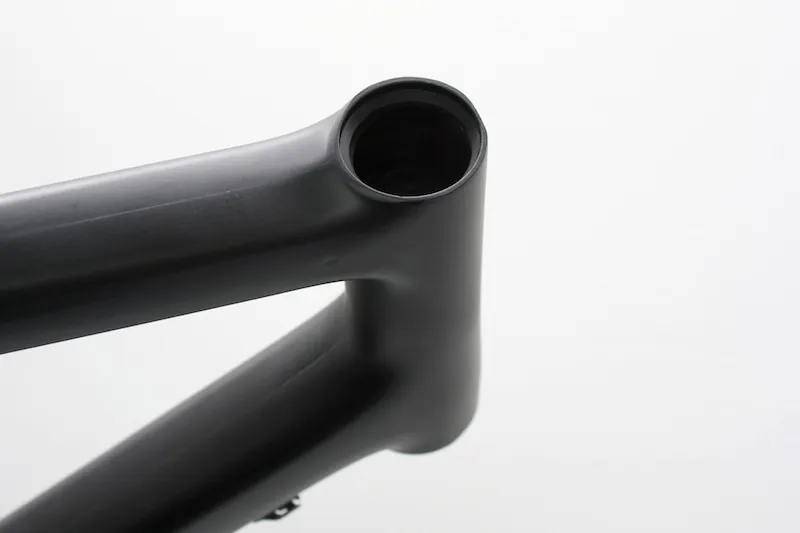
The R5's tapered head tube features moulded bearing seats
BBright
In a move that will surely draw criticism, Cervélo have equipped the new bike with yet another bottom bracket standard, BBright. They say it's neither not too wide, nor too narrow, but just right. BBright is basically a wide BB30 crank, with a 30mm diameter spindle and asymmetric bottom bracket shell. It forgoes the normal BB30 advantage of a narrower Q-factor (BBright's Q-factor is similar to current outboard bearing designs) in favour of greatly enhanced stiffness.
In fact, Cervélo claim the system is 40 percent stiffer than a standard BB30 bearing design. Not only does it have a larger spindle and wider bearing stance, but it also allows Cervélo to double the width of the R5's chainstays, as well as enlarge the seat tube and down tube. BBright is an open standard and will be supported by Campagnolo, FSA, Rotor, SRAM and Zipp. Shimano cranks will be compatible with the design through use of an adaptor.
Kervin Quinones, Rotor’s US general manager, filled us in on the details of Rotor’s new BBright compatible 3D30 crank. “It’s basically an external BB30 crank,” he said. "You can actually use the new crank on a standard threaded bottom bracket, kind of like the Zipp design. This was what we wanted to do even before we became involved with the California Project. We weren’t really a fan of the BB30 [design], at least in the carbon versions, because of the wave washer you have to use that puts so much side load on the bearings."
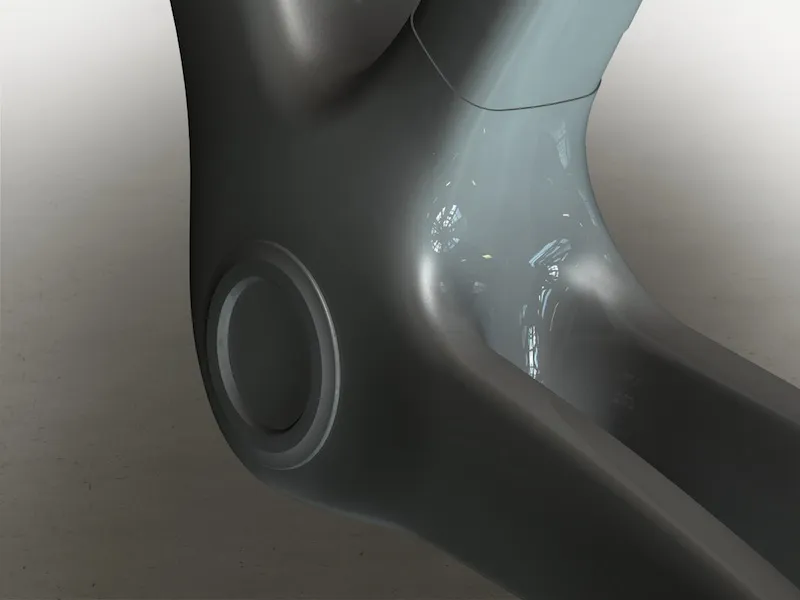
The BBright system in CAD
The Rotor 3D30 crank is still in prototype pre-production form, so details have yet to be completely nailed down, but Quinones said it would not be wider than the current 24mm spindled 3D crank, whose Q-factor is 147mm. The arms are slightly different as they’re drilled entirely from the spindle side and slightly narrower in width. Instead of a wave washer, Rotor’s crank uses a non-drive side threaded preload adjuster, similar to that found on Shimano’s XTR mountain bike crank.
The most impressive feature of the 3D30 crank will be its compatibility. Through use of spindle spacers it will fit both traditional BB30 and BBright bottom bracket standards, plus PressFit 30 and Specialized’s OSBB. With use of a yet-to-be manufactured bottom bracket, tentatively called BSA 30, it will also fit any standard threaded BB shell. Rotor plan to offer the 3D30 cranks with 130mm and 110mm BCDs (standard and compact road configurations) as well as double and triple mountain bike versions.
Unconfirmed pre-production weight of the 3D30 is 500g for the crankarms and spindle, plus 159g for the standard Rotor rings and roughly 10g for bolts, bringing the system to a claimed 669g. Quinones said the new cranks would be available for sale in September, but were likely to see extensive use by the Test Team this summer. The standard 3D crank will stay in Rotor’s line because the 3D30 design is not cross-compatible with Trek’s BB90 or Shimano’s BB86 bottom brackets.
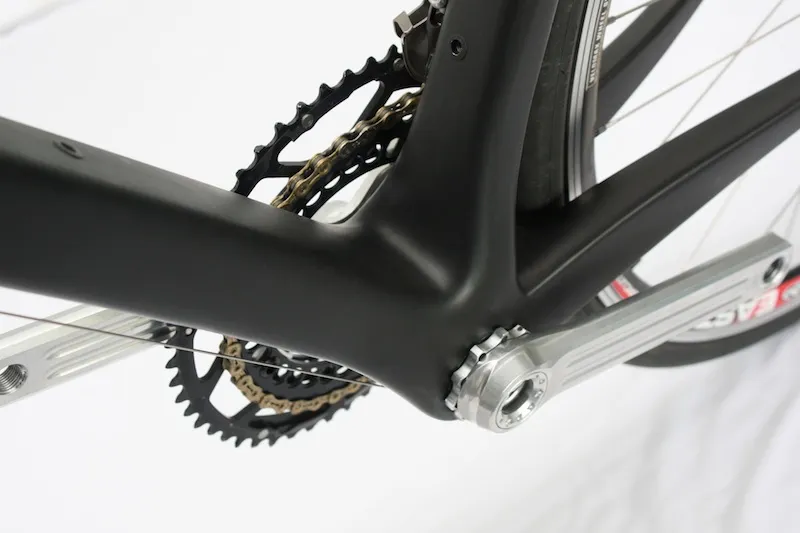
The Cervélo R5ca will come equipped with a Rotor 3D30 crank
Fitting refined
Cervélo believe that top, seat and head tube measurements are poor ways to determine a frame’s fit. They instead suggest that a frame should fit by stack and reach measurements. Stack is measured from the centre of the bottom bracket vertically to the top of the head tube, while reach is measured from the centre of the head tube horizontally to the centre of the bottom bracket.
With Cervélo’s refined geometry, as the stack increases so does the reach in a linear fashion, which is based on anthropometric (body measurement research) data gathered by the US Department of Defense and UK Ministry of Defence standards. Cervélo believe their geometry can fit 98 percent of body proportions and, as proof, cite that all 25 male and 14 female Cervélo Test Team riders fit on stock bikes.
Taking the R5ca to the races
Brett Lancaster rode a version of the R5ca at last week’s Tour of California. To keep the bike within the UCI weight limit, Cervélo mechanics had to stick two full-length chains (keep in mind that each of SRAM’s PC-1090R chains weighs 255g) down the seat tube, plus a custom-made 562g weight (because they couldn't fit any more chains in).
Claimed weight for the R5ca Lancaster rode was 685g, which means he raced with more weight in ballast than actual frame mass. Why bother making it so light? “As we said, the knowledge gain was the real focus of the project,” said White. “The fact that we have a 675g frame isn’t really the focus of it. It’s more, 'Wow, we can learn so much more and all of our bikes can be better'.
"We don’t sell any bikes to the Cervélo Test Team, so it’s not a real profit centre for us to try to get Brett to buy one, so yeah, it’s more of a sales thing, and 99.9 percent of our customers don’t need a UCI license or race in UCI races, so I don’t think that’s a significant driver. In the long term, or medium term I guess is the best way to put it, we’ll see the UCI reduce the weight limit, so I think we’ll be ready for that when it comes.”
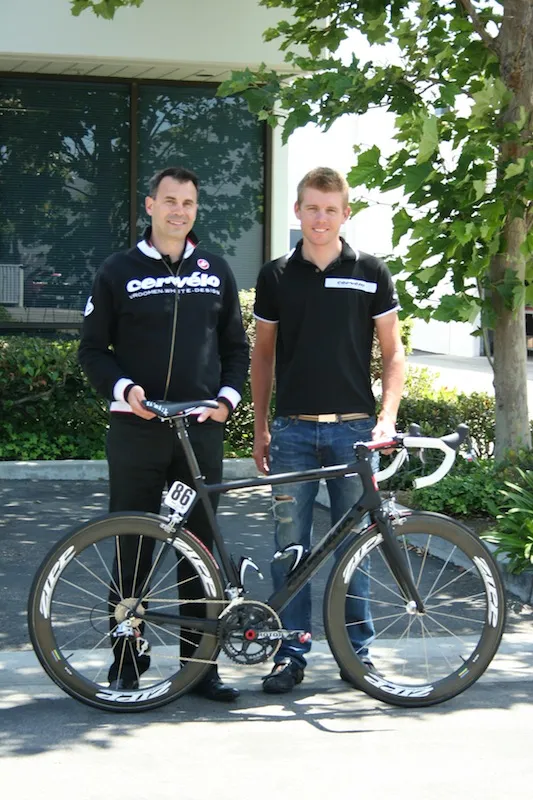
Phil White and Brett Lancaster with the R5ca. Brett raced the bike at the Tour of California
About Project California
Cervélo stress that the R5ca is a product of three years of bicycle design education, not three years of frame development. Project California was set up to help Cervélo’s engineers understand how to develop better bicycles. As with any engineering project, however, the end result is a new product. “You have to make something,” said White. “It’s not a real profit centre to make this frame. The real profit of it, if you want to put it that way, will be the benefits that accrue to the rest of the model line [in terms] of how we can make bikes better all the way across it.”
The first step was to set up a California-based design facility, since Cervélo’s base in Toronto, Canada doesn’t offer year-round ride testing abilities. Their Garden Grove facility flies completely under the radar; the building is devoid of logos or signage. Inside, the majority of the space is dedicated to R&D, carbon manufacturing and prototype testing. There is one small conference room and just a few small offices.
The first product to come out of this new facility was a strain gauge bike. Cervélo engineers took an alloy S1 and wired it for data collection of the bending and twisting of the frame out on the road. Then they rode the hell out of it, testing the following situations: out of saddle climbing, seated climbing, downhill, slight turns, 180-degree cornering, sweeping curves, seated high power and standing sprints.
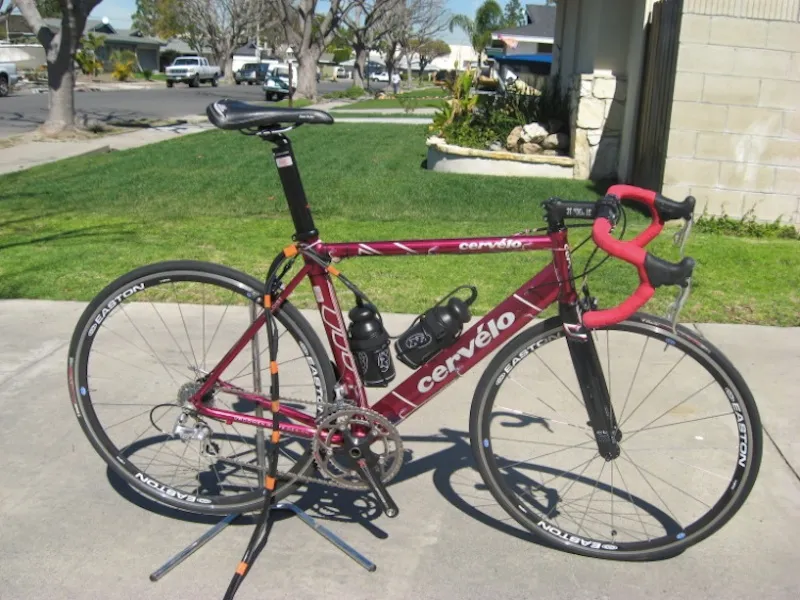
The S1 strain gauge bike produced data that radically changed Cervélo's testing protocols
The goal was to use the data collected to develop lab tests that could replicate and assess these ‘real world’ loads, the end goal being to better correlate test rider feedback with lab tests. Cervélo say that there was a significant difference between the loads created on the road and those previously used in the lab, especially in the top tube and down tube areas. They also found that this difference created higher bending loads in the seat tube than initially assumed.
This new data led to the need for a more complex carbon layup and the subsequent development of CETOP, Cervélo’s internally developed FEA (finite element analysis) pre-processing tool, which is used to pre-test geometry, tube shapes and basic carbon layup. It also resulted in the commissioning of high power laminate processing software from the company Anaglyph.
This offers FEA analysis of individual plies in a layup with up to 350 individual pieces, allowing Cervélo to test layups for performance and failure without building a sample of each prototype configuration. Once the best layup was determined using the software, the results were verified with physical prototype testing. “The bike behaves on our test rig the way the bike behaves in the field,” said White.
“Now we can design a bike virtually, so it becomes faster to design, but we can also make it much lighter" he said. “You can see that the weight we dropped was fairly significant, and now we can go apply those learnings to other bikes. I would expect to see some mix of increased stiffness and decreased weight ... [in] the next generation of products.”
Checking it twice
Cervélo claim their internal testing requirements are generally 20 percent greater than industry standards. Head tube impact testing is a claimed 87 percent tougher, while bottom bracket fatigue testing is done over two million cycles versus the industry standard of 100,000. The company also have a number of proprietary tests, including a vibration test, inclined bottom bracket test and new fork steerer tube impact and fatigue tests. This testing carries across the line, so even if you can’t afford the R5ca, you’re still getting a product that lives up to the standards to which Cervélo’s greatest is built.
